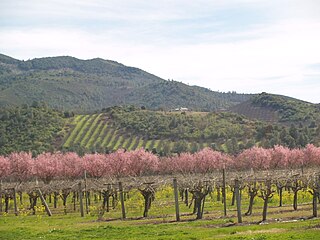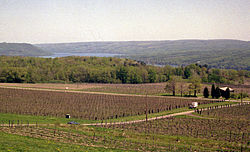
The Yadkin Valley AVA is an American Viticultural Area that includes land in seven counties of northwestern North Carolina. The AVA encompasses an area of approximately 1,400,000 acres (5,666 km2) in the Yadkin River valley. The Yadkin Valley AVA includes all of Wilkes, Surry, and Yadkin counties, and parts of Davie, Davidson, Forsyth, and Stokes counties. Yadkin Valley is home to 45 wineries.

Illinois wine refers to any wine that is made from grapes grown in the U.S. state of Illinois. In 2006, Shawnee Hills, in southern Illinois, was named the state's first American Viticultural Area. As of 2008, there were 79 wineries in Illinois, utilizing approximately 1,100 acres (4.5 km2) of vines.

Washington wine is a wine produced from grape varieties grown in the U.S. state of Washington. Washington ranks second in the United States in the production of wine. By 2017, the state had over 55,000 acres (220 km2) of vineyards, a harvest of 229,000 short tons (208,000 t) of grapes, and exports going to over 40 countries around the world from the 940+ wineries located in the state. While there are some viticultural activities in the cooler, wetter western half of the state, the majority (99.9%) of wine grape production takes place in the shrub-steppe eastern half. The rain shadow of the Cascade Range leaves the Columbia River Basin with around 8 inches (200 mm) of annual rain fall, making irrigation and water rights of paramount interest to the Washington wine industry. Viticulture in the state is also influenced by long sunlight hours and consistent temperatures.
The state of Oregon in the United States has established an international reputation for its production of wine, ranking fourth in the country behind California, Washington, and New York. Oregon has several different growing regions within the state's borders that are well-suited to the cultivation of grapes; additional regions straddle the border between Oregon and the states of Washington and Idaho. Wine making dates back to pioneer times in the 1840s, with commercial production beginning in the 1960s.

The Applegate Valley AVA is an American Viticultural Area located in southern Oregon. It is entirely contained within the Rogue Valley AVA, which is itself included within the larger Southern Oregon AVA. The region is named for the Applegate River, which flows through the town of Applegate and near the city of Jacksonville. The Applegate Valley has been a grape-growing region since 1870 when A. H. Carson began planting 30 acres of grapes along North Applegate Road. One of Oregon's first wineries was established in the Applegate Valley. This region contains vineyards at altitudes ranging from 1,000 feet (300 m) to 1,500 feet (500 m) above sea level, and is warmer and drier than the Illinois Valley to the west, but less so than the Bear Creek Valley to the east. Grapes that thrive here include Tempranillo, Merlot, Cabernet Franc, Cabernet Sauvignon, Syrah, Tannat, Vermentino, Chardonnay, and Zinfandel.

Red Mountain is an American Viticultural Area (AVA) that encompasses the local region surrounding Red Mountain in Benton County, Washington. The viticultural area was formally recognized on June 11, 2001 by the Bureau of Alcohol, Tobacco and Firearms (ATF), Treasury after reviewing the petition submitted by Lorne Jacobson of Hedges Cellars to establish an area known as "Red Mountain." It lies entirely within the Yakima Valley and vast Columbia Valley appellations and is the smallest AVA in the state at only 4,040 acres (6.31 sq mi) in area and lies between Benton City and the City of West Richland. The area has more than 2,225 acres (900 ha) under cultivation of primarily red varietals including Cabernet Sauvignon, Merlot, Sangiovese, Cabernet Franc and Syrah. The reputation of the area's wines has brought Red Mountain worldwide attention and acclaim for producing some of the most desired Washington State vintage wines.

Horse Heaven Hills is an American Viticultural Area (AVA) in southeastern Washington lying in portions of Klickitat, Yakima, and Benton counties, north and west of the Columbia River and south of the Yakima Valley and lies within the vast Columbia Valley appellation. Horse Heaven Hills was established by the Alcohol and Tobacco Tax and Trade Bureau {TTB), Treasury on June 30, 2005 after reviewing the petition filed by Paul D. Lucas on behalf of regional wine grape growers. Horse Heaven Hills viticultural area is about 60 miles (97 km) long and 22 miles (35 km) wide located 115 miles (185 km) east from Vancouver, Washington. The appellation encompasses 570,000 acres (891 sq mi) with about 6,400 acres (2,590 ha) under vine.

New York wine refers to wine made from grapes grown in the U.S. state of New York. New York ranks third in grape production by volume after California and Washington. 83% of New York's grape area is Vitis labrusca varieties. The rest is split almost equally between Vitis vinifera and French hybrids.

Sonoma County wine is wine made in Sonoma County, California, in the United States.

The Dry Creek Valley AVA is an American Viticultural Area in Sonoma County, California, located northwest of the town of Healdsburg. The valley is formed by Dry Creek, a tributary of the Russian River, and is approximately 16 miles (25.7 km) long and 2 miles (3.2 km) wide. The appellation benefits from the proximity of the Lake Sonoma reservoir for irrigation in this relatively dry area.

The Spring Mountain District AVA is an American Viticultural Area located in the Napa Valley AVA in California. Spring Mountain District AVA was officially established as an American Viticulture Area in 1993. Encompassed within its bounds are about 8,600 acres (3,480 ha), of which about 1,000 acres (400 ha) are planted to vineyards. Given the small crop yields on hillsides, the region represents less than 2% of Napa Valley wine. Currently the region has just over 30 winegrowers.

Wisconsin wine refers to wine made from grapes grown in the U.S. state of Wisconsin. Wisconsin is part of the largest American Viticultural Area (AVA), the Upper Mississippi Valley AVA, which includes southwest Wisconsin, southeast Minnesota, northeast Iowa, and northwest Illinois. The state also has two smaller designated American Viticultural Areas, the Lake Wisconsin AVA and the Wisconsin Ledge AVA.

Lake County wine designates wine made from grapes grown mostly in Lake County, California. The region is located north of Napa County and east of Mendocino County. Although each region within Lake County has unique viticultural attributes, many are influenced by Clear Lake, the largest inland body of water in California.

The Hermann AVA is an American Viticultural Area located in Gasconade County, Missouri, and entirely contained within the larger Ozark Mountain AVA. The wine appellation is located on the southern side of the Missouri River near the town of Hermann, about halfway between St. Louis and Jefferson City. The AVA covers the northernmost hills of the Ozark Plateau with many of the 200 acres of vineyards planted along hillside locations. As of 2007, seven wineries were producing wine in appellation, including Missouri's largest winery, Stone Hill Winery.

The Old Mission Peninsula AVA is an American Viticultural Area located in Grand Traverse County, Michigan known for well-regarded Michigan wine. The Old Mission Peninsula extends northward from Traverse City into the Grand Traverse Bay of Lake Michigan, ending at Old Mission Point. The peninsula is 19 miles (31 km) long by 3 miles (5 km) wide at its widest point. The climate on the peninsula is moderated by the surrounding waters, helping to prevent frost during the growing season. Grape varietals suitable to cool climates, such as Riesling, Chardonnay, Gewürztraminer, Pinot gris, Pinot noir, Cabernet Franc, and Merlot do best in the Old Mission Peninsula AVA.
The Shawnee Hills AVA is an American Viticultural Area located between the Mississippi River and the Ohio River in southern Illinois. The wine appellation includes over 2,140 square miles (5,500 km2) of land in portions of Alexander, Gallatin, Hardin, Jackson, Johnson, Pope, Pulaski, Randolph, Saline, Union, and Williamson counties. The region stretches approximately 80 miles (130 km) east-west and 20 miles (30 km) north-south, and includes the vast majority of the Shawnee National Forest.

The Finger Lakes AVA is an American Viticultural Area located in Upstate New York, south of Lake Ontario. It was established in 1982 and encompasses the eleven Finger Lakes, but the area around Canandaigua, Keuka, Seneca, and Cayuga Lakes contain the vast majority of vineyard plantings in the AVA. Cayuga and Seneca Lakes each have their own American Viticultural Areas completely contained within the Finger Lakes AVA. The Finger Lakes AVA includes 11,000 acres (4,452 ha) of vineyards and is the largest wine-producing region in New York State.

Naches Heights is an American Viticultural Area (AVA) in Yakima County, Washington. The AVA was recognized officially by the Alcohol and Tobacco Tax and Trade Bureau {TTB), Treasury on January 13, 2012 after reviewing the petition submitted by R. Paul Beveridge, owner of Wilridge Winery and Vineyard, to establish the viticultural area named "Naches Heights." The AVA is located entirely within the vast Columbia Valley AVA with the city of Yakima to the southeast in a valley at a lower elevation. The Naches Heights appellation encompasses 13,254 acres (21 sq mi) and contains 105 acres (42 ha) of commercial vineyards either producing or expecting to produce wine grapes in the foreseeable future. Additionally, it is the first AVA in Washington state to be fully sustainable, with all 7 vineyards practicing in either biodynamic or LIVE certification. At the recognition date, only 37.2 acres (15 ha) were under vine, making the AVA the smallest planted wine region in Washington.

The Wisconsin Ledge AVA is an American Viticultural Area in northeast Wisconsin along the Niagara Escarpment in Door, Kewaunee, Manitowoc, Sheboygan, Ozaukee, Washington, Dodge, Fond du Lac, Calumet, Outagamie, and Brown counties. Certified by the United States Department of the Treasury's Alcohol and Tobacco Tax and Trade Bureau on March 22, 2012, it covers an area of 3,800 sq mi (9,800 km2) and is the second AVA designation wholly in Wisconsin, following the Lake Wisconsin AVA established in 1994. The state's third is the gargantuan Upper Mississippi River Valley AVA which also covers land in Minnesota, Iowa and Illinois. After 7 long years, and 4000 hours, Steven J. DeBaker of Trout Springs Winery was granted his petition to the TTB for establishment of the Wisconsin Ledge AVA. It became the 203rd AVA in the US, including just under 2.5 million acres making it the 12th largest AVA in the US. Today, there are 24 bonded wineries that lie within the AVA with over 400 acres of vines planted.
Upper Lake Valley is an American Viticultural Area (AVA) in Lake County, California, established in June 2022 and encompassing 17,360 acres (70.3 km2). The appellation lies between 1,326 feet (404 m) and 2,820 feet (860 m) in a series of valleys north of the unincorporated towns of Upper Lake and south of the Mendocino National Forest, and a stretch of Clear Lake's north shore which extends from Upper Lake in the west to the unincorporated community of Nice to the east. The Elk Mountain Valley AVA designation was originally suggested, but after consultation with the Alcohol and Tobacco Tax and Trade Bureau (TTB), it was abandoned in 2018 for the more encompassing Upper Lake Valley appellation.















